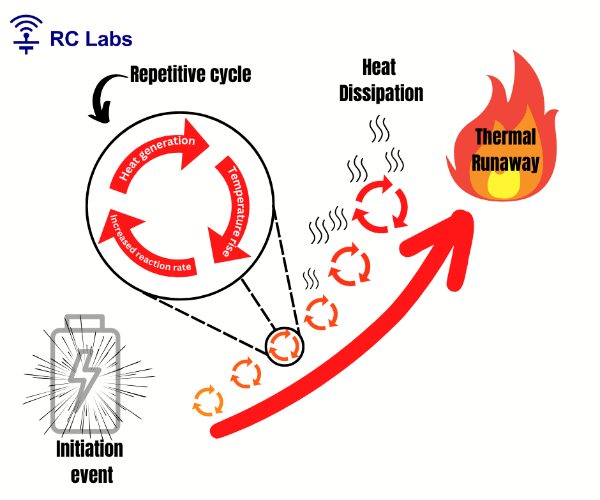Preventing Battery Fires: Understanding the Causes of Thermal Runaway
Thermal runaway is a critical issue in battery technology, especially Lithium based ones, characterized by a rapid and uncontrollable rise in temperature beyond safe limits. This phenomenon can lead to cell and battery failures, as well as fires and explosions that put the vehicle and the user life at risk. The heat generated by the system exceeds its capacity for dissipation, causing a thermal chain reaction that can quickly spread to adjacent cells and modules. Onset temperature, the point at which thermal runaway begins, varies depending on the battery chemistry in use. For example, LFP Li-ion batteries tend to experience thermal runaway at around 195 degrees Celsius, while NMC Li-ion batteries may reach this point at 180 degrees Celsius. Thermal runaway poses a severe danger, as it follows a cyclic pattern in which each effect leads to the next, creating a dangerous feedback loop that can quickly escalate out of control.
As depicted in the article’s cover image, thermal runaway occurs when an initial event triggers a rapid temperature rise, which in turn accelerates the reaction rate and generates even more heat. This creates a dangerous feedback loop, where the heat generated exceeds the system’s ability to dissipate it, causing the temperature to rise further. This self-sustaining cycle can continue until the battery fails catastrophically or ignites, posing a significant risk to the battery and anyone nearby.
There are several reasons for this phenomenon to occur :
Suboptimal thermal management: If the heat generated by the battery exceeds its capacity for dissipation, the temperature can rise steadily over time, leading to thermal runaway.
Overcharging: Excessive charging can cause the battery’s internal resistance to increase, resulting in excess charge current being converted to heat. This can trigger thermal runaway, which is why it’s important to avoid overcharging, even with batteries equipped with good battery management systems (BMS).
Short circuit: A sudden and intense flow of current during a short circuit can generate significant heat, increasing the likelihood of connectors or components catching fire and leading to thermal runaway.
Manufacturing defects: Although cells undergo inspection before being sold, defects can still occur during manufacturing. Issues such as separator integrity or poor cell quality can lead to internal short circuits, which in turn increases the risk of thermal runaway.
Operation in extreme temperatures: While cells are designed to work within a certain temperature range, prolonged use at extreme temperatures can trigger thermal runaway. Typically cells (or battery packs) are manufactured to withstand temperatures as low as -20 degrees C to as high as 60 degrees C, with cells of different make even working at wider limits, but it’s not recommended to use cells for a longer time at extreme temperatures.
To effectively prevent thermal runaway, manufacturers must prioritize battery safety in their designs and ensure proper ventilation.One highly effective solution is to incorporate a cooling system into the battery pack, which can absorb and dissipate heat to keep the battery at a safe temperature. Furthermore, module-to-module protection materials like composites, aerogel insulation layers can limit the spread of thermal runaway within a single module and prevent it from spreading to adjacent modules.
Having a smart BMS equipped with precise detection and advanced predictive algorithms is crucial to monitor the battery’s condition and provide an early warning in case of any indication of thermal runaway.

